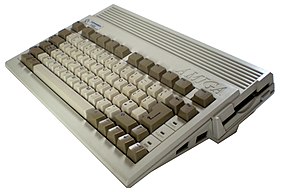Amiga 600
 |
|
| Manufacturer | Commodore |
|---|---|
| Type | Home computer |
| Release date | March 1992 |
| Discontinued | 1993 |
| Operating system | AmigaOS 2.05 (up to 3.1 with ROM replacement and 3.9 with CPU upgrade) |
| CPU | Motorola 68000 @ 7.16 MHz 7.09 MHz (PAL) |
| Memory | 1 MB (80 ns access time) (6 MB Maximum, more with unofficial expansions) |
| Predecessor | Amiga 500, Amiga 500 Plus |
| Successor | Amiga 1200 |
The Amiga 600, also known as the A600 (codenamed "June Bug" after a B-52s song), is a home computer that was introduced at the CeBIT show in March 1992. The A600 is Commodore International's final model based on the Motorola 68000 CPU and the ECS chipset. It is essentially a redesign of the Amiga 500 Plus, with the option of an internal hard disk drive. A notable aspect of the A600 is its small size. Lacking a numeric keypad, the A600 is only slightly larger than a standard PC keyboard (14" wide by 9.5" long by 3" high and weighing approximately 6 pounds). It shipped with AmigaOS 2.0, which was generally considered more user-friendly than earlier versions of the operating system.
Like the A500, the A600 was aimed at the lower end of the market, with the higher end being dominated by the Amiga 3000. It was intended by Commodore to revitalize sales of the A500-related line before the introduction of the 32-bit Amiga 1200. According to Dave Haynie, the A600 "was supposed to be 50–60 US$ cheaper than the A500, but it came in at about that much more expensive than the A500." This is supported by the fact that the A600 was originally to have been numbered the A300, positioning it as a lower-budget version of the A500+. In the event, the cost led the machine to be marketed as a replacement for the A500+, requiring a change of number. Early models feature motherboards and power supplies with the A300 designation.
The managing director of Commodore UK, David Pleasance, described the A600 as a "complete and utter screw-up". In comparison to the popular A500 it was considered unexpandable, did not improve on the A500's CPU, was more expensive, and lacked a numeric keypad meaning that some existing software such as flight simulators and application software cannot be used without a numerical pad emulator.
...
Wikipedia
